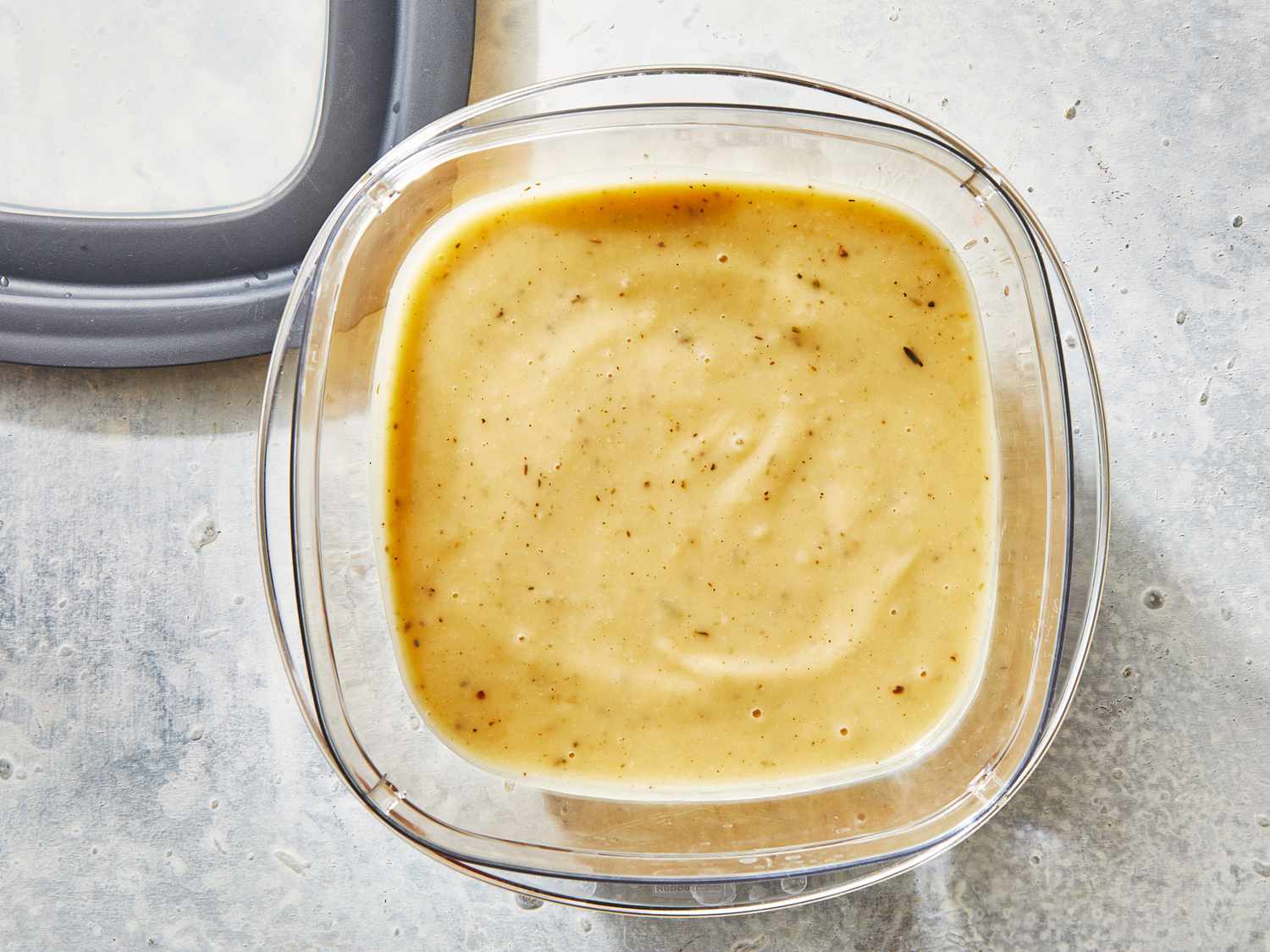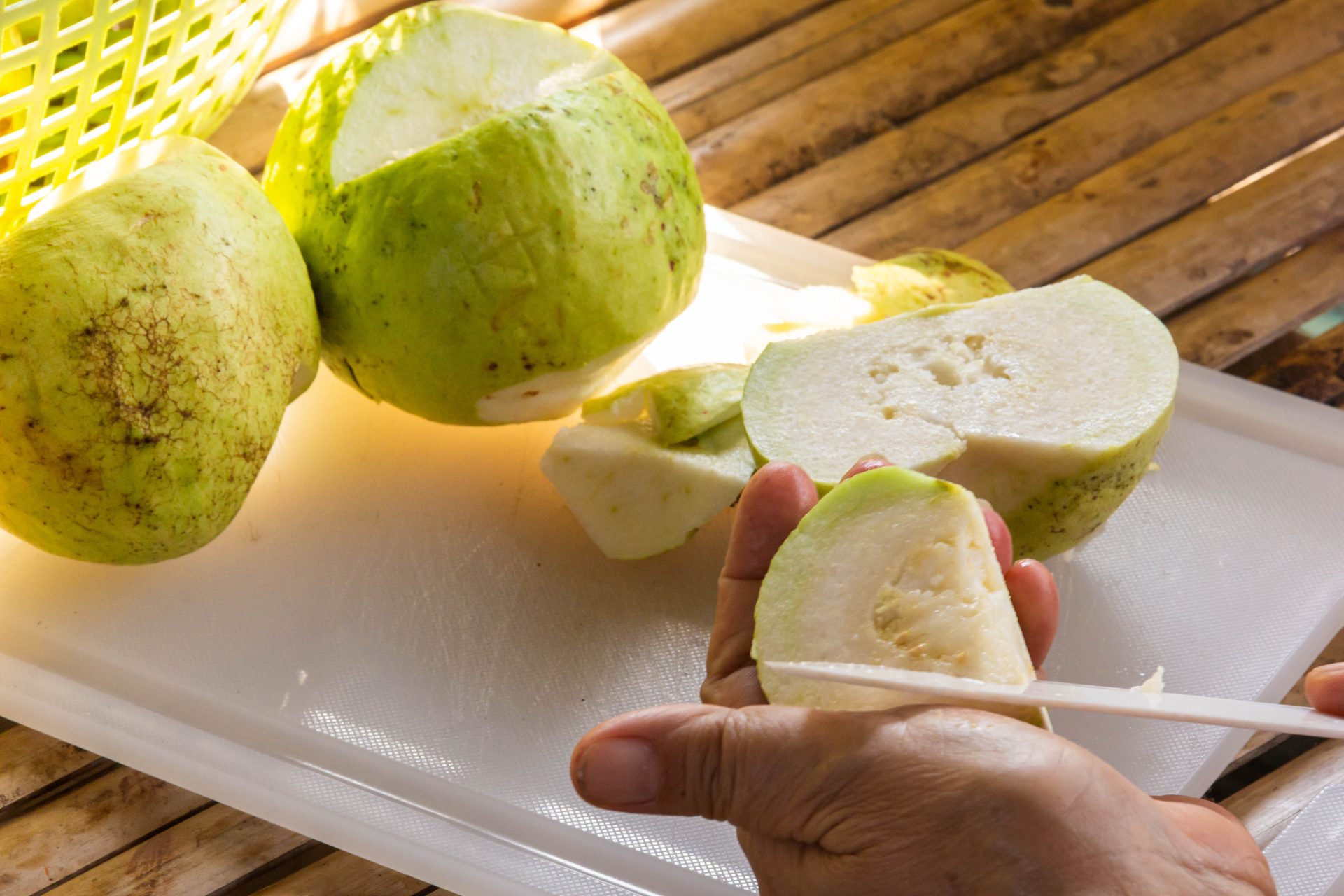

Articles
How To Store Gravy
Modified: January 5, 2024
Learn the best ways to store gravy and keep it fresh for future use with these helpful articles.
(Many of the links in this article redirect to a specific reviewed product. Your purchase of these products through affiliate links helps to generate commission for Storables.com, at no extra cost. Learn more)
Introduction
Welcome to the world of delicious homemade gravy! Whether you’re a seasoned cook or just starting out in the kitchen, one thing is for certain: gravy is the finishing touch that can elevate any meal. It adds a rich and savory flavor that complements everything from roasted meats to Thanksgiving feasts.
However, as any gravy connoisseur knows, it can be a challenge to store gravy properly. Improper storage can lead to spoilage, loss of flavor, or even foodborne illnesses. This is why knowing the right techniques and equipment for gravy storage is crucial to maintain its quality and ensure its shelf life.
In this article, we will guide you through the process of storing gravy correctly. We’ll discuss the importance of proper storage, the equipment you’ll need, and provide you with a step-by-step guide to ensure your gravy stays fresh and delicious.
So, let’s dive in and discover the secrets to preserving your delectable gravy!
Key Takeaways:
- Properly storing gravy is crucial for maintaining its flavor, safety, and quality. Follow the step-by-step guide and tips to ensure your homemade gravy stays fresh and delicious for longer periods.
- Avoid common mistakes such as leaving gravy at room temperature for too long or using improper storage containers. By maintaining proper food safety practices and using quality ingredients, you can enjoy delicious homemade gravy on demand.
Why is Proper Gravy Storage Important
Proper gravy storage is essential for several reasons. Firstly, it helps to maintain the flavor and consistency of the gravy over time. Gravy that is not stored correctly can develop off flavors, become lumpy, or lose its richness and depth of flavor. By using appropriate storage techniques, you can preserve the delicious taste of your gravy for longer.
Secondly, storing gravy correctly helps to prevent foodborne illnesses. Gravy is a perishable item that can harbor bacteria if not stored at the proper temperature. When gravy is left at room temperature for an extended period, harmful bacteria can multiply and cause food poisoning. It’s important to follow the recommended storage guidelines to ensure the safety of you and your loved ones.
Furthermore, proper storage allows you to make larger batches of gravy in advance, saving you time and effort during busy meal preparations. By storing gravy properly, you can make it ahead of time and enjoy it later without compromising its quality. This is especially beneficial during holiday gatherings and special occasions when you have multiple dishes to prepare.
Lastly, proper gravy storage can help you reduce waste and save money. When gravy is not stored correctly and goes bad, it needs to be discarded. This can be a significant waste of both ingredients and effort. By implementing proper storage techniques, you can extend the lifespan of your gravy, ensuring that it doesn’t go to waste and that you get the most out of your culinary creations.
Overall, proper gravy storage is important to maintain its flavor, ensure food safety, save time, and prevent unnecessary waste. Taking the necessary steps to store your gravy correctly will not only enhance your dining experience but also give you peace of mind knowing that you’re serving safe and delicious meals.
Equipment Needed for Gravy Storage
When it comes to storing gravy, having the right equipment is key to maintaining its quality and extending its shelf life. Here are some essential items you’ll need for gravy storage:
- Storage containers: Invest in high-quality, airtight containers specifically designed for food storage. Glass or BPA-free plastic containers with tight-fitting lids are ideal for storing gravy. Make sure the containers are clean and dry before use to prevent any contamination.
- Labels and markers: It’s important to label your gravy containers with the date they were prepared. This will help you keep track of how long the gravy has been stored and ensure you use it before it spoils. Use a waterproof marker to write the date on the container or use adhesive labels that can be easily removed.
- Freezer bags: If you prefer to freeze your gravy, freezer bags are a convenient option. Look for heavy-duty freezer bags that are durable and leak-proof. Make sure to remove any excess air from the bags before sealing to prevent freezer burn.
- Permanent marker: You’ll need a permanent marker to write the date and contents on the freezer bags. This will help you identify the gravy easily and keep track of its storage time.
- Aluminum foil or plastic wrap: If you plan to refrigerate your gravy for a short period, covering the container with aluminum foil or plastic wrap can help maintain its freshness and prevent it from absorbing any odors from other foods in the refrigerator.
- Ice cube trays: Ice cube trays can be useful if you prefer to portion out your gravy into smaller servings. Simply pour the gravy into the trays, freeze, and then transfer the frozen gravy cubes into a freezer bag for easier storage and portion control.
- Thermometer: A food thermometer is handy for ensuring that your gravy reaches the proper temperature before storage. It will help you determine when the gravy has cooled enough to be transferred to the refrigerator or freezer.
Having these essential equipment items on hand will make the gravy storage process much smoother and more efficient. They will help you maintain the quality, safety, and longevity of your delicious homemade gravy.
Step-by-Step Guide to Storing Gravy
Now that you have the necessary equipment for gravy storage, it’s time to learn the step-by-step process. Here’s a guide to help you store your gravy correctly:
- Cool the gravy: Allow the freshly cooked gravy to cool at room temperature for about 30 minutes. This will prevent condensation from forming inside the storage container and ensure that the gravy retains its proper consistency.
- Choose the storage container: Select a clean, airtight container that is appropriate for the amount of gravy you have. Consider using individual-sized containers for portion control or larger ones for family servings.
- Label the container: Use a marker or adhesive labels to write the date and contents on the container. This will help you identify the gravy easily and keep track of its storage time.
- Transfer the gravy: Carefully pour the cooled gravy into the chosen storage container, leaving about half an inch of headspace to allow for expansion during freezing.
- Seal the container: Ensure that the container’s lid is securely fastened to create an airtight seal. This will prevent air from entering and help maintain the quality and flavor of the gravy.
- Refrigerate or freeze: If you plan to use the gravy within a few days, place the container in the refrigerator. For longer storage, transfer the container to the freezer.
- Refrigerator storage: Keep the gravy refrigerated at or below 40°F (4°C) and consume it within 2 to 3 days. Make sure to check for any signs of spoilage, such as an off odor or unusual texture, before reheating and consuming.
- Freezer storage: If you opt to freeze the gravy, it can be stored for up to 3 months. However, for the best flavor, it is recommended to use it within 1 to 2 months. Remember to thaw the frozen gravy in the refrigerator overnight before reheating.
- Thaw and reheat: When you’re ready to enjoy your stored gravy, thaw it in the refrigerator overnight if frozen. Heat it on the stovetop or microwave, stirring occasionally, until it reaches an internal temperature of 165°F (74°C) throughout.
Following these steps will ensure that your gravy is stored correctly, maintaining its delicious flavor and preventing any potential food safety issues. Now you can have homemade gravy readily available whenever you need it!
Store gravy in an airtight container in the refrigerator for up to 3-4 days. To freeze, pour into an ice cube tray and transfer to a freezer bag once frozen. Thaw in the refrigerator before reheating.
Tips for Maintaining Gravy Quality
Keeping your gravy at its best quality requires some extra care and attention. Here are some helpful tips to help you maintain the flavor, texture, and overall quality of your stored gravy:
- Use fresh ingredients: Start with high-quality ingredients when making your gravy. Fresh stocks, meat drippings, and herbs will contribute to a more flavorful and rich gravy that will hold up better during storage.
- Strain the gravy: After cooking, strain the gravy to remove any lumps or solid particles. A smooth and velvety texture will ensure a better quality gravy when reheated.
- Cool quickly: To prevent bacterial growth, cool the gravy as quickly as possible before transferring it to storage containers. You can use an ice bath or divide it into smaller batches to expedite the cooling process.
- Avoid overcooking: Be cautious not to overcook the gravy, as this can cause it to become too thick or lose its flavor. Cook it just until it reaches the desired consistency, then remove it from the heat promptly.
- Portion control: Consider dividing the gravy into smaller portions before storage. This allows you to thaw and use only the amount you need, reducing waste and ensuring optimum freshness.
- Avoid reheating multiple times: Try to reheat only the portion of gravy you intend to use. Repeated heating and cooling can cause the gravy to break down and lose its smooth texture.
- Defrost slowly: When thawing frozen gravy, do it slowly in the refrigerator overnight to maintain the best quality and prevent any flavor or texture changes.
- Stir while reheating: When reheating the gravy, stir it occasionally to distribute the heat evenly and prevent any scorching or uneven reheating.
- Use proper reheating methods: Reheat the gravy on the stovetop over low heat or in the microwave at medium power. This gradual heating will help maintain its consistency and prevent overheating.
- Taste and adjust: Before serving the reheated gravy, taste it and adjust the seasonings if necessary. The flavors may have intensified during storage, so a touch of salt, pepper, or herbs may be needed to balance the taste.
By following these tips, you’ll ensure that your stored gravy maintains its quality and tastes just as delicious as when it was freshly made. With a little extra care, you can enjoy flavorful and satisfying gravy whenever you desire!
Common Mistakes to Avoid
When it comes to storing gravy, there are a few common mistakes to be aware of. By avoiding these mistakes, you can ensure that your gravy stays fresh, flavorful, and safe to consume. Here are some common mistakes to watch out for:
- Leaving gravy at room temperature for too long: Leaving gravy at room temperature for an extended period is a recipe for foodborne illness. Bacteria can multiply rapidly in the temperature danger zone (40°F to 140°F or 4°C to 60°C), so it’s important to cool the gravy quickly and store it in the refrigerator or freezer as soon as possible.
- Not using airtight containers: Gravy easily absorbs odors and flavors from other foods in the refrigerator. Failing to store it in airtight containers can result in off-flavors and spoilage. Invest in high-quality containers with tight-fitting lids to maintain the integrity of your gravy.
- Using containers that are too large: Using containers that are much larger than the amount of gravy can result in increased air exposure, leading to faster spoilage. Choose containers that provide just enough space for your gravy without excessive headspace.
- Freezing gravy in unsuitable containers: If you choose to freeze your gravy, make sure the containers are freezer-safe and won’t crack or break when frozen. Avoid using glass containers that may shatter due to expansion during freezing.
- Not properly labeling containers: Forgetting to label your gravy containers with the date and contents can lead to confusion and potentially storing them for too long. Take a moment to label each container to keep track of storage time and prevent any unpleasant surprises down the line.
- Keeping gravy in the refrigerator for too long: While gravy can stay in the refrigerator for a few days, it’s best to consume or freeze it within 2 to 3 days for optimal freshness. Leaving it in the refrigerator for too long can lead to spoilage and a potential waste of food.
- Freezing hot gravy: Putting hot gravy directly into the freezer can raise the temperature inside the freezer, potentially causing other frozen items to thaw. Allow the gravy to cool to room temperature before transferring it to the freezer to maintain the freezer’s temperature stability.
- Thawing and refreezing gravy: It’s best to avoid thawing and refreezing gravy multiple times. Each time the gravy goes through the thawing and refreezing process, its quality can degrade. Instead, divide the gravy into smaller portions before freezing to only thaw what you need at a time.
By being aware of these common mistakes and taking the necessary precautions, you can ensure that your gravy stays fresh, safe to consume, and retains its delicious flavor throughout its storage period.
Frequently Asked Questions
Q: How long can I store gravy in the refrigerator?
A: Gravy can be stored in the refrigerator for 2 to 3 days. It’s important to consume or freeze it within this timeframe to maintain its freshness and safety.
Q: Can I freeze leftover gravy?
A: Yes, leftover gravy can be frozen for up to 3 months. However, it’s best to use it within 1 to 2 months for the best flavor and quality.
Q: Can I store gravy at room temperature?
A: It is not recommended to store gravy at room temperature for an extended period. Bacteria can grow rapidly in the temperature danger zone, which can lead to foodborne illnesses. It’s best to cool and store gravy in the refrigerator or freezer as soon as possible.
Q: Should I allow the gravy to cool before storing it?
A: Yes, it’s important to allow the gravy to cool for about 30 minutes at room temperature before transferring it to storage containers. This helps prevent condensation and maintains the gravy’s proper consistency.
Q: How should I thaw frozen gravy?
A: The best way to thaw frozen gravy is by transferring it from the freezer to the refrigerator and allowing it to thaw overnight. Slow thawing in the refrigerator helps maintain the taste, texture, and overall quality of the gravy.
Q: Can I reheat gravy in the microwave?
A: Yes, you can reheat gravy in the microwave. However, be sure to heat it in short increments, stirring occasionally, to ensure even reheating and prevent scorching. Remember to use microwave-safe containers and follow safe reheating guidelines.
Q: How can I tell if stored gravy has gone bad?
A: If your stored gravy has an off odor, unusual texture, mold growth, or shows signs of spoilage, it is best to discard it. Trust your senses and if in doubt, it’s better to be safe than sorry.
Q: Can I reuse leftover gravy that has been stored?
A: It is generally safe to reuse leftover gravy that has been stored properly. However, it’s important to reheat it to an internal temperature of 165°F (74°C) before consuming. Always use your best judgment and discard any gravy that shows signs of spoilage or has been stored for an extended period.
Q: Can I store different types of gravy together?
A: It is best to store different types of gravies separately to preserve their distinct flavors. If stored together, the flavors may meld, resulting in a less desirable taste.
Q: Can I freeze gravy made with flour as a thickener?
A: Yes, gravy made with flour as a thickener can be frozen. However, it may undergo slight texture changes when thawed and reheated. Stirring the thawed gravy well can help restore its consistency.
If you have any further questions or concerns about storing gravy, it’s always a good idea to consult reliable sources or a food safety expert to ensure you’re following best practices for safe and delicious gravy storage.
Conclusion
Properly storing gravy is essential for maintaining its flavor, safety, and overall quality. By following the step-by-step guide and implementing the tips mentioned in this article, you can ensure that your homemade gravy stays fresh and delicious for longer periods.
Remember to cool the gravy before transferring it to airtight containers suitable for refrigerator or freezer storage. Label the containers with the date and contents to keep track of their storage time. Refrigerate or freeze the gravy based on your intended usage timeframe, making sure to thaw it properly before reheating.
Avoid common mistakes such as leaving gravy at room temperature for too long, using improper storage containers, or refreezing the gravy multiple times. These mistakes can compromise the flavor, texture, and safety of your gravy.
By maintaining proper food safety practices and using quality ingredients, you can enjoy delicious homemade gravy on demand. Whether it’s a comforting Sunday roast or a festive holiday meal, having well-stored gravy at your fingertips will enhance any dish and impress your guests.
So, next time you whip up a batch of your favorite homemade gravy, remember the importance of proper storage. Take care to cool, label, and store it correctly to preserve its delightful flavor and enjoy the convenience of having flavorful gravy ready whenever you need it.
Now that you have the knowledge and tools to store gravy like a pro, go ahead and savor the incomparable taste of your homemade gravy! Happy cooking and happy storing!
Frequently Asked Questions about How To Store Gravy
Was this page helpful?
At Storables.com, we guarantee accurate and reliable information. Our content, validated by Expert Board Contributors, is crafted following stringent Editorial Policies. We're committed to providing you with well-researched, expert-backed insights for all your informational needs.















0 thoughts on “How To Store Gravy”